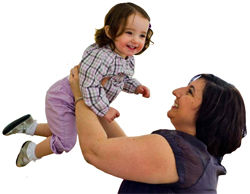Rebecca Byrne had waited years for a doctor to tell her, “You’re pregnant.” She never imagined that just a few months after she first heard those words, she would hear four more: “You have breast cancer.”
Byrne still tears up when telling the story, but smiles when her 20-month-old daughter, Emelia, leaps into her lap. Emelia is the happy outcome of a painful period of Byrne’s life, when the joys of pending and early motherhood were shadowed by chemotherapy treatments, hair loss, radiation, and uncertainty.
Every year in the U.S., one in 3,000 women will be diagnosed with breast cancer during pregnancy. Many obstetricians and oncologists have never managed these dual challenges, but Dana-Farber/Brigham and Women’s Cancer Center in Boston has become a leader in achieving healthy outcomes for patients and their babies.

The key is to look at each case individually, explains Ann Partridge, MD, MPH, director of Dana-Farber/Brigham and Women’s Cancer Center’s Program for Young Women with Breast Cancer.
The program helps women in their early 40s and younger before, during, and after cancer treatment, and works in collaboration with the reproductive endocrinology and high-risk pregnancy centers at partnering Brigham and Women’s Hospital, where individuals like Byrne can consider their reproductive options.
When she was initially diagnosed at age 34, Byrne didn’t even know pregnant women could develop the disease. But a few days later, doctors told Byrne that she should seriously consider terminating her pregnancy and having a mastectomy. Her physicians also mentioned a Dana-Farber/Brigham and Women’s Cancer Center doctor who they felt had more experience and could offer other options. Soon thereafter, Byrne met with Partridge.
“The first thing Dr. Partridge told me was, ‘Take a breath; you don’t need to decide today, and you don’t need to have surgery today,'” says Byrne, recalling her initial visit. “She had cared for other patients in my situation, and she said that terminating the pregnancy wouldn’t change my cancer outcome or my treatment.”
Because Byrne was in her second trimester, when the baby was more developed, Partridge said this would be the safest time during pregnancy to have both chemotherapy and any needed surgery.
Partridge also reassured Byrne that her type of breast cancer, HER2-positive invasive ductal carcinoma, was very responsive to a chemotherapy regimen that she could handle while pregnant.
This new information convinced the couple they should keep the baby. Partridge recommended a lumpectomy as a first surgery, rather than a mastectomy. In April 2010, Byrne had two lumpectomies to remove tumors in the breast, along with some surrounding breast tissue.
Before and after each surgery, clinicians let her hear the baby’s heartbeat.
A month later, Byrne started treatment with chemotherapy medications taken every three weeks for a 12-week cycle. Partridge referred her to the high-risk pregnancy center at BWH, where obstetrician Katherine Economy, MD, and her colleagues team with Dana-Farber/Brigham and Women’s Cancer Center oncologists to provide specialized care for patients in this delicate situation.
“We’ve started a working group combining the high-risk center at Brigham and Women’s Hospital and the breast oncology team at Dana-Farber/Brigham and Women’s Cancer Center – including medical oncologists, surgeons, radiation oncologists, social workers, radiologists, and nurses – to develop standards and coordinate the care of such patients, as well as conduct research in this area,” says Partridge. “We’d love for more women like Rebecca to have this type of outcome.”
Byrne’s year of chemotherapy treatment ended in August 2011, and she is now focused fully on her family and career. Emelia is a healthy, happy, mile-a-minute toddler, and the garage in which Byrne sat and cried after hearing her diagnosis now holds strollers and diapers.
She comes to see Partridge at Dana-Farber/Brigham and Women’s Cancer Center once every four months for a checkup.
“Dr. Partridge wants me to wait until March 2013 to start trying to have another baby, since that will be three years since my diagnosis,” says Byrne. Then she beams at Emelia.
“I’m not sure I can wait.”
This story originally appeared in the Spring/Summer 2012 issue of Paths of Progress. Read the full story and find out how to download the Paths of Progress app for your tablet.

What a terrific success story! We should have thousands more of Dr. Partridge and Dr. Katherine Economy and a whole lot more of Dana-Farber/Brigham and Women/s Cancer Centers. Lastly, Kudos to Rebecca Byrne for her courage!